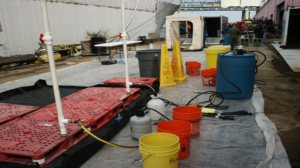If you look at the decontamination equipment stored at most hospitals you would think they have two dozen trained Hospital Emergency Response Team (HERT) members to set-up and operate the decontamination corridor. Many hospitals were recipients of a cache of decontamination equipment as part of a grant program and/or donations from nearby fire departments upgrading theirs. Equipment typically includes large tents and pallet loads of supplies and equipment. The problem is that many hospitals have just a handful of HERT trained personnel. Your training program needs to be customized for your facility, staff, equipment, threats and desired outcomes. 
Equipment and staffing are important factors when looking at training options. It’s much safer and wiser to scale your HERT program based upon the number of staff you can realistically field rather than how much equipment you can set up given enough time. Decontamination is a process and there are literally dozens of way to meet the objective of ensuring someone is clean enough not to represent a hazard to staff.
If you can’t staff more than 1-4 people a shift, your decontamination corridor should be simple and your training process built around standard operating procedures you want your staff to follow. Expecting a contaminated patient in duress to wait while extensive equipment is set-up is not realistic and one of two things will happen. Option one – Medical staff will attend to the patient prior to any decontamination or donning of appropriate Personal Protective Equipment (PPE). Option two – the patient will tire of your antics and breach your facility though some door.
Training your staff to be able to quickly set-up a basic decontamination system with staff on duty and readily available will serve you better in most cases than waiting on teams to bring loads of equipment and set-up a “traditional” decontamination tent system. Topics you need to have in your training program include:
- PPE – Selection,use and disposal
- HICS – How the HERT will function and fit in with your facility HICS structure
- Hazard Vulnerability Analysis – What hazards are they likely to encounter
- Decontamination Corridor – How to establish and operate (with realistic staffing)
- Triage – Process to determine who gets decontaminated first
- Decontamination – Methods and desired outcomes
- Hospital policies relative to contaminated patient management
Develop your in-house trainers or collaborate with other facilities in your region to form coalitions of trainers. This can help standardize procedures, sustain programs and build back-up staffing for member hospitals for the rare major hazardous materials event. Your training program does not have to be hundreds of pages but it does need to provide new and existing HERT members the foundation to safely and efficiently manage the contaminated patient. I invite you to share success stories you’ve experienced when it comes to building your HERT program.
Missed an article in this series? Catch up here.




Another great article Jan!
One thing I haven’t read, which was eluded to, is waiting patients with real or potential contamination with methods to immediately address this.
When I was working with the USAF, we almost always found extra treatment gear (bandages, etc.) and decon packets laying around unused and there was usually a spigot near by. In order to keep patients occupied, allowing them a way to start deconning, and to initially treat wounds, place a box of bandages on the hotside and run a garden hose out there. If necessary, especially with civilian patients, get someone, on the cold side with a bullhorn and give some direction, reassurance and timelines while teams are setting up.
If these simple things are done, patients will be less likely to find another entrance or to threaten your team.
I agree 100% that your program must be realistically designed, and if that means identifying workarounds to make a 12 person line, work with 4, so be it. It is worthless, like with any plan or procedure, to have a nice pretty plan that makes auditors and evaluators blush, but isn’t how the work is really done.
Thanks again for sharing your thoughts and experience!